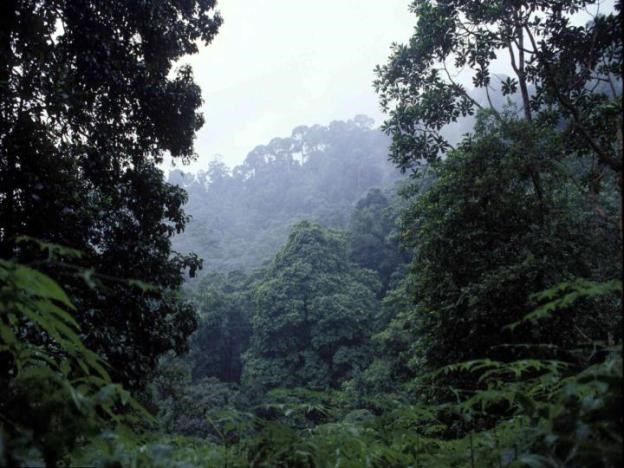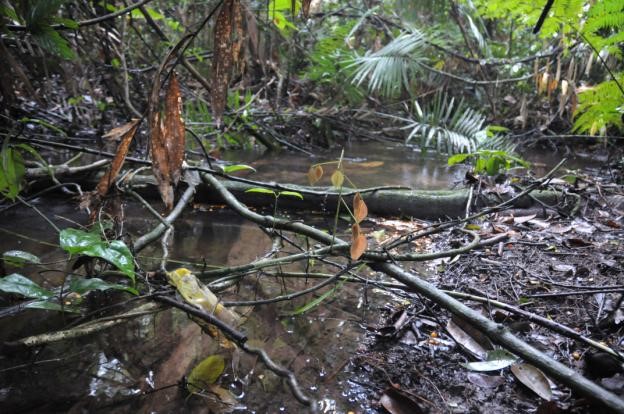Forest
In the moist tropics, forest is the dominant ecosystem in undisturbed areas. There are several forest types that can be distinguished.
Lowland dipterocarp forest
Tall forest that has never been cleared has a continuous history of tree cover of native species. Species diversity and structural diversity are high in this forest and canopy cover is continuous barring treefalls. Dipterocarps (Dipterocarpus, Shorea, Hopea, Vatica spp.) form a large proportion of the canopy-forming trees. Many growth forms including lianes, epiphytes, etc occur, but ground cover is limited by light and leaf litter. Such forests can be found in Bukit Timah Nature Reserve and the Central Catchment Nature Reserve, and in the Singapore Botanic Gardens Rainforest.

Coastal hill forest
Above any splash zone from the sea, on cliffs and hill slopes exposed to drying winds, is this forest that differs subtly from that further inland. It is usually lower in stature than inland primary dipterocarp forest and often contains Tristaniopsis and Rhodamnia. It may support species at low altitude that are confined to higher altitudes further away from the coast. Where disturbed, there is a transition with Adinandra belukar. Hills at Labrador Nature Reserve and in the Western Catchment support fragments of disturbed coastal hill forest, but some botanists would also consider the forest at Bukit Timah Nature Reserve to show indications of its proximity to the coastal environment (e.g., Shorea curtisii growing at low altitude).
Freshwater swamp forest
Forest growing in wet, entirely fresh water, often seasonally flooded lowlands where slow-flowing streams drain shallow valleys. The ground is of mineral soils and often saturated by a high water table, and a proportion of the trees show adaptations such as stilt roots and pneumatophores. This forest can be found in the Central Catchment Nature Reserve, and formerly in Jurong and the centre of Pulau Tekong. Botanists have listed at least 712 plant species from the freshwater swamp forest at Nee Soon. Pometia pinnata (kasai), Palaquium xanthochymum, Mangifera griffithii, Gluta wallichii and Strombosia ceylanica are predominant trees. Many plants and animals are amongst the rarities and species of special concern. The waterlily, Barclaya motley, exemplifies the adaptations in the herb layer, and is susceptible to trampling and change in water table. Many rare plant species in Singapore are now confined to Nee Soon, even if they once occurred in other habitats too.

Secondary forest
‘Secondary’ forest refers to forest that has grown up de novo, following complete removal of earlier forest. In most cases in Singapore, the interval between forest removal and regrowth are long (often, several decades), and involved intermediate stages such as cultivation of crops. Complete removal of earlier forest is detected by the lack of native climax forest trees such as dipterocarps. Secondary forest may be dominated by Albizia falcataria, Acacia auriculiformis, or Spathodea campanulata, and smaller trees such as Cinnamomum iners. In places where old rubber plantations or fruit orchards have been abandoned, a range of native species gradually accumulates over many years.
Thus, the term secondary forest refers mainly to the vegetation structure and history rather than species composition, although fast-growing pioneer species predominate and typically include a range of non-native trees.
Adinandra belukar
Dense growth dominated by Adinandra dumosa, often with a mixture of other trees such as Albizia falcataria and Acacia auriculiformis. It is often found in dryland conditions, with a broken canopy up to 5 or 6 m high. Adinandra dumosa seems to be typical of nutrient poor soils, and open patches may support resam fern, Dicranopteris, and pitcher plants.
Grasslands
Areas dominated by grass are seldom natural in the low-lying tropics such as Singapore. Grass tends to invade ground that has been disturbed, either by human clearance or by repeated flooding or other natural disturbances.
Grassland – Dry
Untended rough grassland, with one to a range of non-lawn grass species, where drainage is good so that there is little or no standing fresh water even after rain, and that quickly disappears. There may be scattered shrubs such as Melastoma and weeds such as Lantana, but these occupy only a small percentage of the area. Tended, mown grass includes sports fields, manicured lawns in parks or gardens, and grass verges along roadsides.
Grassland – Wet
Untended rough grassland, with one to a range of non-lawn grass species, where drainage is poor and standing fresh water remains for long periods. As a result there is often a significant admixture of sedges, tending towards freshwater swamp. There may be scattered shrubs, such as Dillenia suffruticosa, but these occupy only a small percentage of the area. As with Grassland – Dry, many species and individuals of low-growing weeds may occur in interstices amongst the grass.
Recreational parks in urban ecosystems
Urban Parkland
Includes mown grassland of lawn or field species, open grass such as sports fields and parks with planted trees, flowerbeds, pathways and recreational areas. Most of the plant species are ornamental and the trees may be of native or exotic species chosen for characteristics compatible with park use by people.
Urban Buildings
The built environment is generally unaccommodating to native biodiversity, but walls, roofs, tiles, pipes and other structures can still provide space for a range of small organisms. These include lichens (though susceptible to pollution) and mosses (species depending on exposure and dampness), small plants even up to the size of strangling figs were tolerated on derelict buildings, and animals such as molluscs, flies, hymenopterans, spiders, geckos and other small animals.
Urban gardens and verges
Between buildings, along roadsides and in house compounds, gardens and verges are managed environments with small well-spaced trees, usually mown turf and planted ornamentals. Many of the plants are exotics, but others are native species including some deliberately cultivated and others that invade (mosses, fungi, weeds). There may be exposed soil between plants. Garden birds, butterflies and other conspicuous forms may be attracted to flowering and fruiting plants, or to invertebrates on lawns and in soil. Single rows of trees along roadsides and road dividers are included in this category.
Freshwater streams
Streams in forest
Clear running water in a usually shallow channel that may have a sandy (or occasionally muddy earth) bed. Some forest streams in Singapore have been deepened by cutting, giving a U shaped channel. Ferns and other vegetation typically line the banks. There may be stilt-rooted trees, pandans, or other forest-living plants that selectively grow in wet conditions.
Streams in rural areas
Streams running through disturbed and cleared country, with a typically U shaped channel, that may have sandy or muddy banks that support secondary growth of grasses, shrubs. Few now remain without a canalized artificial bed of concrete.
Canalised streams
Concrete or cement lined watercourses, often wide and devoid of vegetation (except perhaps lichens and ferns). Straightening, smoothing of the banks and widening typically result in sluggish flow, except after heavy rain. Nutrient input from streamside vegetation is limited by the artificial character of the banks, but water in canalized streams often derives from catchments that are heavily residential or industrialized, and therefore may receive substantial nutrient input from domestic or other sources. Some canalized streams in Singapore have banks lined with riprap (interlocking concrete blocks in which there may be spaces for plants to grow) but even here the plant growth normally does not extend into the water.
Freshwater ponds
Small and artificial standing water bodies that are created deliberately (e.g., for freshwater aquaculture). Occasionally, they are created by incidental blocking of streams by road construction or other activities.
Reservoirs
Large, artificial standing water bodies created by damming previously existing watercourses, or by de novo construction, for water retention and supply. Although the size difference from ponds is arbitrary, the function (water supply) and history (damming of a water course) are usually distinct. In the Singapore context, some have entirely artificial banks (e.g., Bedok), whereas others are fully surrounded by secondary vegetation or forest (e.g., MacRitchie).